¶ Theoretical aspects
¶ Aircraft manual standard operating procedures
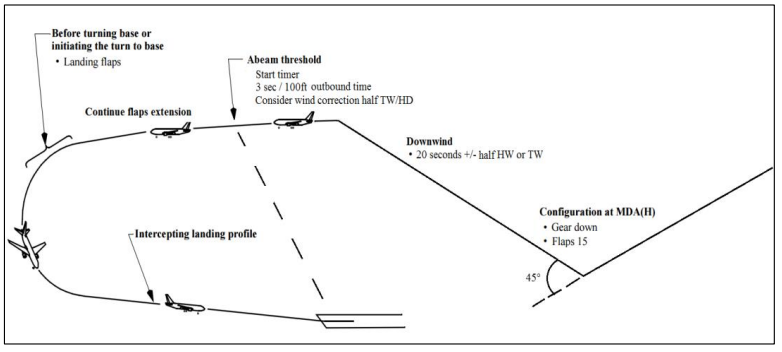
¶ Lateral flightpath
First we need to be established on the instrument approach you have chosen to acquire visual references.
In this case we have chosen a precision ILS CAT I approach. We could have chosen a non-precision approach such as VOR or NDB approach.
High precision ILS CAT II and CAT III approaches are not eligible for circle-to-land manoeuvres and subsequently, CAT I approach must be selected.
Circling minima should normally be the same for all the approach procedures of an airport.
We will find our aircraft established on the localizer a few moments before reaching our MDA.
Upon reaching our MDA or the MAPt, we will open by performing a 45-degree turn either to the left or to the right and remain on this new course for 30 seconds.
Then we will turn toward downwind and we will continue like any visual pattern (start timer across threshold, base turn and final).
The opening can only be made given the pilot has acquired runway visual references and estimates he can maintain visual contact during the whole manoeuvring. Otherwise a go-around must be initiated.
If there is no restriction on the chart prohibiting a direction to perform the circle-to-land, try as much as possible to select the direction using this list of priority:
- If landing is intended on a runway which is not the reciprocal QFU, the shortest way to achieve final.
- The downwind leg which is not the published one for VFR flights
- Turn as to keep the runway on your left side (captain) / right side (FO) for better visibility
¶ Vertical flightpath
Our aircraft will be descending, established on the final approach course and the pilot flying should level his aircraft when clear of clouds, at the latest reaching the MDA.
The instrument approach final descent shall not be continued below MDA, even with visual references.
Since a circle-to-land is generally at low height (typically 700ft AGL) compared to visual traffic patterns (standard on B737 is 1500ft AAL), final descent should be initiated on final leg.
Remember, you may accept a positive deviation but you must never descend below MDA unless you are in position to perform final descent (normally not before entering base turn).
¶ Speed management
As the aircraft is performing an indirect approach, the pilot flying should operate a stabilized approach.
However, since we need to manoeuvre the aircraft, we will not prepare our aircraft in the landing configuration.For the Boeing B737, we will maintain:
- Vref+15, meaning about 160 IAS, and allowing a standard 25° bank angle.
- Final approach speed Vref when established on final.
Speed is critical, in particular when auto thrust is not used. Attention to aircraft energy is important!
¶ Preparatory work
¶ Scenario
Approach will be FTTJ ILS Y RWY05 Circling RWY23
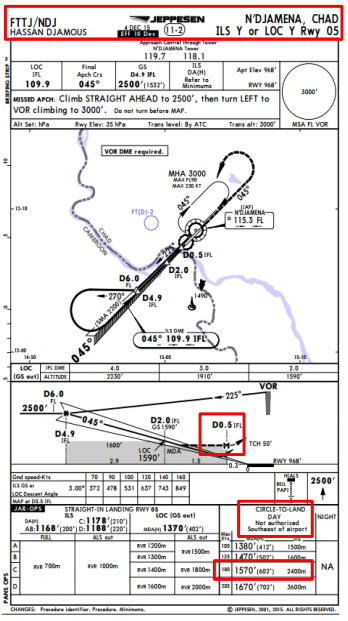
- Minima for CAT C: DA - 1570' (DH - 602')
- Required visibility for CAT C: 2400m
- Missed Approach Point: 0.5NM IFL DME
- Prohibited Sector: Yes, southeast
- Opening Turn: 45° Left (Toward Northwest)
- Maximum IAS: 180 kts
¶ Lateral path calculations
Remain in the 4.5NM-protected circling area (CAT C) independently of your calculations.
The opening leg is always 20 seconds
The outbound time requires an easy calculation:

Abeam threshold, we will start the timer for a duration of 18 seconds
Both durations need to be corrected by adding or subtracting half of the headwind or tailwind component in seconds (not considered in this example)
Review appropriate documentation to determine headwind/tailwind component calculations.
¶ Vertical flightpath
Using the previous method to determine the lateral flightpath, you do not need to perform calculations regarding your descent.
At the end of the final turn, you should be in position for a 3-degree standard descent.
In addition, most runways are equipped with visual guidance systems such as PAPI.
Remember: the final descent should be initiated only when in position to do so at a correct sink rate and established on the runway axis
¶ Flying the circle-to-land
Even though we rely on instruments, you must acquire, maintain and use visual references!
¶ End of ILS approach
At this point, the following aircraft configuration has to be set while descending established on the ILS:
- Aircraft is at Vref+15 (approx. 160kts)
- Aircraft is Flaps 15 and Gear is down.
- Minima are identified: 1570 feet in this case.
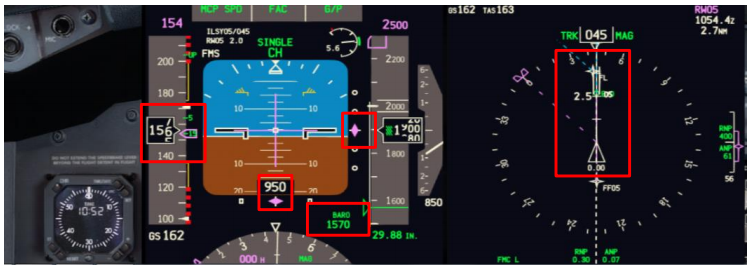
When reaching MDA, level off the aircraft.
You see the runway and consider the whole circling achievable in regard to visual flight. In that case you may enter into the opening leg. Check every circling steps (downwind, base and final).
Use the FPV (Flightpath Vector) also named "The Bird" if available for enhanced flight accuracy
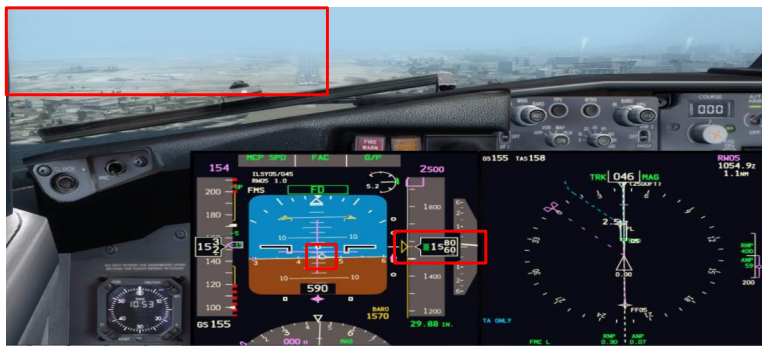
If you do not see the runway, you may proceed until the MAPt at MDA before initiating a go-around.
You may also stop the descent at a higher altitude than the MDA (Recommended on unmanned facilities)
¶ Opening leg
When you are confident about performing the circling, perform the opening by turning to the left (in this case) by 45 degrees.
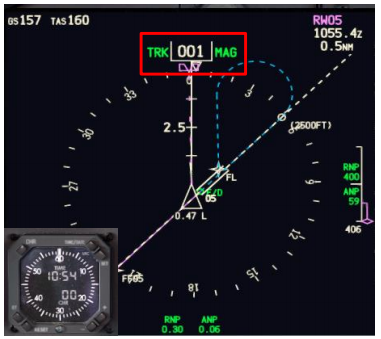
We were established on course 046°.
Our new course will be 001°.
As soon as wings are leveled, start timer.
As briefed, leg time is 20 seconds (no wind).
Do mind the wind to not get pushed onto the runway because of the drift.
It will result in an overshoot when performing the last turn to final.
Aircraft remains in the same configuration.
¶ Downwind leg
At the end of timer, perform a 45 degree turn toward the runway to enter downwind.
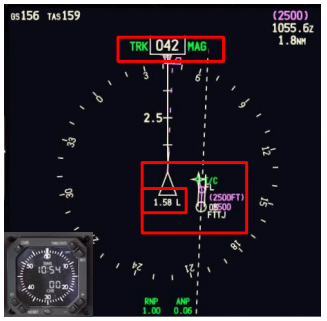
We were established on course 001°.
Our new course will be 046°.
When flying abeam threshold (confirm visually), start timer
Leg time using previous formula is 18 seconds.
There is no wind so no correction.
Optimum lateral distance with runway is 2.2NM. Adjust!
Continue flaps extension; before base turn, set landing flaps.
If you are flying an advanced depiction of this aircraft, change arrival runway (if able).
¶ Base and final leg
At the end of timer, perform base turn starting with a 20-degree bank angle.
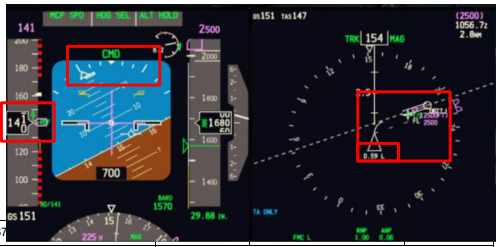
At half of the turn but not before:
- Reduce speed to approach speed
You may check at half turn that your distance to the runway centerline is good: at 140kts, the optimum value is 0.7NM.
Adjust turn speed by modifying bank angle (max value is 30°).
At the end of the turn, visually adjust your position with the runway.
Normally you should be a bit below the normal descent path.
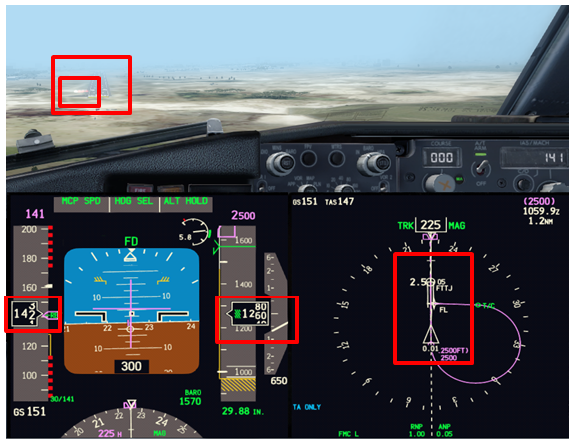
Do not initiate descent below MDA if not established on final leg or if position is uncertain.
Use any means to confirm your descent:
- Visual guidance such as PAPI
- Instrumental references
Do not forget your landing checklist!
¶ Map of the flightpath
![]()
¶ Case of aborted approach and go-around
In case of aborted approach (which can be due to loss of visual references), the situation is critical!
Your reaction is subsequent to your position in the circling:
- Before being abeam the runway threshold, turn toward the airfield and rejoin the original instrument approach published missed approach path.
- If you are at a later stage, turn toward the airfield, climbing in circles while remaining in the protected area and rejoin as soon as possible a suitable course toward the missed approach path.
- In case of go-around on final, perform a standard visual traffic pattern.
If unable, climb using maximum rate of climb to safe altitude, in circles to remain in the protected area.
- Boeing FCTM (modified)
- VID 200696 - Creation
- VID 496402 - Wiki.js integration